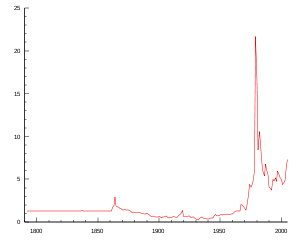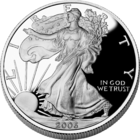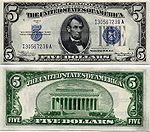Silver as an investment
From Wikipedia, the free encyclopedia
Silver, like other precious metals, may be used as an investment. For more than four thousand years, silver has been regarded as a form of money and store of value. However, since the end of the silver standard, silver has lost its role as legal tender in the United States. (It continued to be used in coinage until 1964, when the intrinsic value of the silver overtook the coins' face values.)
Contents |
[edit] Silver price
The price of silver has been notoriously volatile as it can fluctuate between industrial and store of value demands. At times this can cause wide ranging valuations in the market, creating volatility.
Silver often tracks the gold price due to store of value demands, although the ratio can vary. The gold/silver ratio is often analyzed by traders and investors and buyers. In 1792, the gold/silver ratio was fixed by law in the United States at 1:15 [1], which meant that one troy ounce of gold would buy 15 ounces of silver; a ratio of 1:15.5 was enacted in France in 1803[2]. The average gold/silver ratio during the 20th century, however, was 1:47 [3].

| Year | Silver price (yearly avg.[1]) US$/oz |
Gold price (yearly avg.[2]) US$/oz |
Gold/silver ratio |
|---|---|---|---|
| 1840 | 1.296 | 20.65 | 15.93 |
| 1850 | 1.292 | 20.65 | 15.98 |
| 1860 | 1.292 | 20.65 | 15.98 |
| 1870 | 1.430 | 20.65 | 14.44 |
| 1880 | 1.116 | 20.66 | 18.51 |
| 1890 | 1.056 | 20.66 | 19.56 |
| 1900 | 0.648 | 20.68 | 31.91 |
| 1910 | 0.553 | 20.64 | 37.32 |
| 1920 | 0.655 | 20.68 | 31.57 |
| 1930 | 0.330 | 20.65 | 62.58 |
| 1940 | 0.348 | 33.85 | 97.27 |
| 1950 | 0.800 | 34.72 | 43.4 |
| 1960 | 0.914 | 35.27 | 38.59 |
| 1970 | 1.635 | 35.94 | 21.98 |
| 1980 | 16.393 | 612.56 | 37.37 |
| 1990 | 4.068 | 383.51 | 94.27 |
| 1991 | 3.909 | 362.11 | 92.63 |
| 1992 | 3.710 | 343.82 | 92.67 |
| 1993 | 4.968 | 359.77 | 72.42 |
| 1994 | 4.769 | 384.00 | 80.52 |
| 1995 | 5.148 | 384.17 | 74.63 |
| 1996 | 4.730 | 387.77 | 81.98 |
| 1997 | 5.945 | 330.98 | 55.67 |
| 1998 | 5.549 | 294.24 | 53.03 |
| 1999 | 5.218 | 278.88 | 53.45 |
| 2000 | 4.9506 | 279.11 | 56.38 |
| 2001 | 4.3702 | 271.04 | 62.02 |
| 2002 | 4.5995 | 309.73 | 67.34 |
| 2003 | 4.8758 | 363.38 | 74.53 |
| 2004 | 6.6711 | 409.72 | 61.42 |
| 2005 | 7.3164 | 444.74 | 60.79 |
| 2006 | 11.5452 | 603.46 | 52.27 |
| 2007 | 13.3836 | 695.39 | 51.96 |
| 2008 | 14.9891 | 871.96 | 58.17 |
| 2009 (as of Feb 19) | 14.0200 | 970.00 | 69.19 |
From September 2005 onwards, the price of silver has risen fairly steeply, being initially around $7 per troy ounce but reaching $14 per oz. for the first time by late April 2006. The monthly average price of silver was $12.61 per ounce during April 2006, and the spot price was around $15.78 per ounce on November 6, 2007. As of March 2008, it hovered around $20 per troy ounce. [4]. However, the price of silver plummeted 58% in October 2008, along with other metals and commodities, due to the effects of the credit crunch. [5]
[edit] Factors influencing the silver price
- Private and institutional investors
- From 1973 the Hunt brothers began cornering the market in silver, helping to cause a spike in 1980 of $49.45 per ounce and a reduction of the gold/silver ratio down to 1:17.0 (gold also peaked in 1980, at $850 per ounce) [6]. However, a combination of changed trading rules on the New York Mercantile Exchange (NYMEX) and the intervention of the Federal Reserve put an end to the game.
- In 1997, Warren Buffett purchased 130 million ounces (4,000 metric tons) of silver at $4.41 per ounce (total value $572 million). Similar to gold, the silver price has more than doubled in value against the United States dollar since December 2001 [7]. On May 6, 2006, Buffett announced to shareholders that his company no longer held any silver. In April 2006 iShares launched a silver exchange-traded fund, called the iShares Silver Trust (NYSE: SLV), which as of April 2008 held 180 million ounces of silver as reserves.
- The large concentrated short position
- The CFTC publishes a weekly Commitments of Traders Report which shows that the four or fewer largest traders are holding 90% of all short silver contracts. Furthermore, these four or fewer traders were short a total of 245 million ounces (as of April 2007), which is equivalent to 140 days of production. [8]
On 2008-09-25 The CFTC finally relented and probed the Silver Market after persistent complaints of foul play draw the still-skeptical Agency to investigate http://online.wsj.com/article/SB122231175151874367.html?mod=rss_markets_main
- Industrial demand
- The use of silver in items such as electrical appliances and medical products has increased since 2001. New applications for silver are being explored in batteries, superconductors and microcircuits, which may further increase non-investment demand. The expansion of the middle classes in emerging economies aspiring to Western lifestyles and products may also contribute to a long-term rise in industrial usage.[9] Even so, due to the advent of digital cameras the enormous reduction in the use of silver halide-based photographic film has tended to offset this.[citation needed]
[edit] Methods of investing in silver
[edit] Bars
A traditional way of investing in silver is by buying actual bullion bars. In some countries, like Switzerland and Liechtenstein, bullion bars can be bought or sold over the counter at major banks.
Physical silver, such as bars or coins, may be stored in a home safe, a safe deposit box at a bank, or placed in allocated (also known as non-fungible) or unallocated (fungible or pooled) storage with a bank or dealer.
Various sizes of silver bars:
- 1000 oz troy bars – These bars weigh about 68 pounds avoirdupois (31 kg) and vary about 10% as to weight, as bars range from 900 oz to about 1100 oz (28 to 34 kg). These are COMEX good delivery bars.
- 100 oz bars – These bars weigh 6.8 pounds (3.11 kg) and are among the most popular with retail investors. Popular brands are Engelhard and Johnson Matthey. Those brands cost a bit more, usually about 40-80 cents per ounce above the spot price, but that price may vary with market conditions.
- Odd weight retail bars – These bars cost less and generally have a wider spread, due to the extra work it takes to calculate their value and the extra risk due to the lack of a good brand name.
- 1 kilogram bars (32.15 oz)
- 10 oz bars and 1 oz bars (311 and 31.1 g)
[edit] Coins

Buying silver coins is another popular method of physically holding silver. One example is the 99.99% pure Canadian Silver Maple Leaf. Coins may be minted as either fine silver or junk silver, the latter being older coins with a smaller percentage of silver. U.S. coins 1964 and older (half dollars, dimes, and quarters) are 25 grams per dollar of face value and 90% silver (22½ g silver per dollar). (All 1965-1970 and one half of the 1975-1976 Bicentennial San Francisco proof and mint set Kennedy half dollars are "clad" in a silver alloy and contain just under one half of the silver in the pre-1965 issues.)
Junk silver coins are also available as sterling silver coins, which were officially minted until 1919 in the United Kingdom and Canada and 1945 in Australia. These coins are 92.5% silver and are in the form of (in decreasing weight) Crowns, Half-crowns, Florins, Shillings, Sixpences, and threepence. The tiny threepence weighs 1.41 grams, and the Crowns are 28.27 grams (1.54 grams heavier than a US $1). Canada produced silver coins with 80% silver content from 1920 to 1967.
[edit] Rounds
Some hard money enthusiasts use .999 fine silver rounds as a store of value. A cross between bars and coins, silver rounds are produced by a huge array of mints, generally contain an ounce of silver in the shape of a coin, but have no status as legal tender. Rounds can be ordered with a custom design stamped on the faces or in assorted batches.
[edit] Certificates

A certificate of ownership can be held by silver investors instead of storing the actual silver bullion. Silver certificates allow investors to buy and sell the security without the difficulties associated with the transfer of actual physical silver. The Perth Mint Certificate Program (PMCP) is the only government-guaranteed silver-certificate program in the world.
The U.S. dollar has been issued as silver certificates in the past, each one represented one silver dollar payable to the bearer on demand. The notes were issued in denominations of $10, $5, and $1 and can no longer be redeemed for silver.
[edit] Accounts
Most Swiss banks offer silver accounts where silver can be instantly bought or sold just like any foreign currency. Unlike physical silver, the customer does not own the actual metal but rather has a claim against the bank for a certain quantity of metal. Many digital gold currency providers, such as e-gold and GoldMoney, offer silver as an alternative to gold and work on a similar principle. Other electronic silver accounts include the eLibertyDollar and Phoenix Silver. Silver accounts are backed through unallocated or allocated silver storage.
[edit] Exchange-traded funds
Exchange-traded funds (or ETFs) represent a quick and easy way for an investor to gain exposure to the silver price, without the inconvenience of storing physical bars. The silver ETFs are:
- iShares Silver Trust (NYSE: SLV), launched in April 2006 by iShares.
- Central Fund of Canada (TSX: CEF.NV.A, NYSE: CEF), which has 45% of its reserves held in silver with the remainder invested in gold.
- In September 2006 ETF Securities launched ETFS Silver (LSE: SLVR), which tracks the DJ-AIG Silver Sub-Index, and later in April 2007 ETFS Physical Silver (LSE: PHAG), which is backed by allocated silver bullion.
- PowerShares DB Silver (AMEX: DBS), holds its worth in futures contracts for physical delivery, which are later sold to silver consumers in order to roll over expiring contracts to contracts further from expiration.
[edit] Spread betting
Firms such as Cantor Index, CMC Markets and IG Index, all from the UK, offer the ability to take a bet on the price of silver through what is known as a spread bet.
[edit] Derivatives
Derivatives, such as silver futures and options, currently trade on various exchanges around the world. In the U.S., silver futures are primarily traded on COMEX (Commodity Exchange), which is a subsidiary of the New York Mercantile Exchange. In November 2006, the National Commodity and Derivatives Exchange (NCDEX) in India introduced 5 kg silver futures [10].
[edit] Mining companies
These do not represent silver at all, but rather are shares in companies that mine silver. Companies rarely mine silver alone, as normally silver is found within, or alongside, ore containing other metals, such as tin, lead, zinc or copper. Therefore shares are also a base metal investment, rather than solely a silver investment. As with all mining shares, there are many other factors to take into account when evaluating the share price, other than simply the commodity price. Instead of personally selecting individual companies, some investors prefer spreading their risk by investing in precious metal mining mutual funds.
[edit] Taxation
In many tax regimes, silver does not hold the special position that is often afforded to gold. For example, in the European Union the trading of recognized gold coins and bullion products is VAT exempt, but no such allowance is given to silver. This makes investment in silver coins or bullion less attractive for the private investor, due to the extra premium on purchases represented by the irrecoverable VAT (charged at 17.5% in the United Kingdom and 19% for bars and 7% for bullion products with face value, e.g. US Silver Eagle and Maple Leaf, in Germany).
Other taxes such as capital gains tax may apply for individuals depending on country of residence (tax status) and whether the asset is sold at increased value.

